Connection diagram for solar panels: to the controller, to the battery and to the serviced systems
Autonomous power supply systems of suburban facilities allow you to live in comfort even far from centralized communications. Often, along with traditional schemes, alternative ones based on the use of solar energy are used.
In order for the solar system to function correctly, a well-designed wiring diagram for connecting solar panels is necessary. It will require a set of quality equipment that can cope with its responsibilities.
We will tell you how to properly plan the placement of components of a mini-power plant. You will learn how to choose technical devices for assembling the system and how to connect them correctly. Based on our advice, you can build an effective installation.
The content of the article:
The scheme of the solar power plant
Consider how the heliosystem is arranged and works for a country house. Its main purpose is to convert the energy of the sun into 220 V electricity, which is the main source of power for home electrical appliances.
The main parts of which the SES consists of:
- Batteries (panels) that convert solar radiation into direct current.
- Battery Charge Controller
- Battery pack
- An inverter that converts battery voltage to 220 V.
The battery design is thought out in such a way that allows the equipment to function in various weather conditions, at temperatures from -35ºС to + 80ºС.
It turns out that correctly installed solar panels will work with the same performance both in winter and summer, but under one condition - in clear weather, when the sun gives off the maximum amount of heat. The cloudy performance drops dramatically.
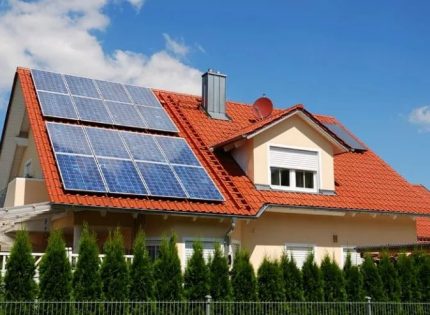
The weight of one 300 W battery is 20 kg.Most often, panels are mounted on the roof, facade or special racks installed next to the house. Necessary conditions: a turn of the plane towards the sun and an optimal slope (on average 45 ° to the earth's surface), ensuring a perpendicular fall of sunlight.
If possible, install a tracker that tracks the movement of the sun and adjusts the position of the panels.
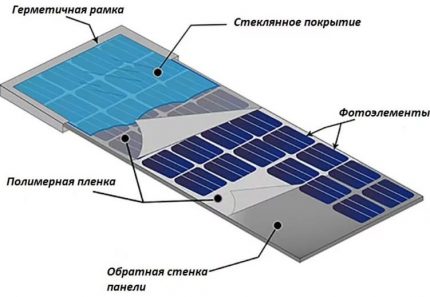
The controller performs how many functions. In addition to the main - automatic battery charge adjustment, controller regulates the supply of energy from solar panels, thereby protecting the battery from complete discharge.
When fully charged, the controller automatically disconnects the battery from the system. Modern devices are equipped with a control panel with a display showing the voltage of the batteries.
For self-made solar systems, the best choice is gel batteries, which differ in the period of uninterrupted functioning of 10-12 years. After 10 years of operation, their capacity decreases by about 15-25%. These are maintenance-free and absolutely safe devices that do not emit harmful substances.
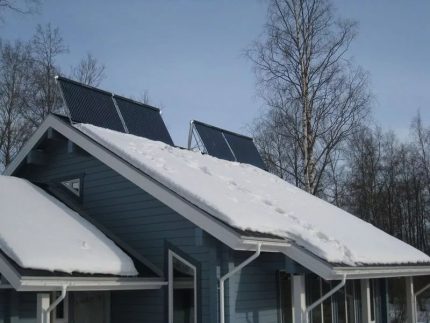
Task inverters - convert the direct voltage from the battery to an alternating voltage of 220 V. They differ in such technical characteristics as the power and quality of the received voltage. Sinus equipment is able to service the most “moody” devices for current quality - compressors, consumer electronics.
Overview of household SES:
It is worth knowing that household power plants are capable of servicing a constantly working refrigerator, a submersible pump, a TV, and a lighting system that is periodically launched. To provide energy for the functioning of a boiler or even a microwave, more powerful and very expensive equipment will be required.
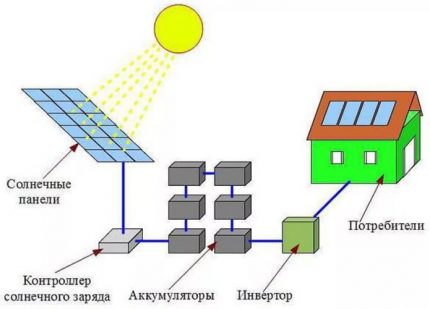
There are other, more complex assembly schemes for solar power plantsHowever, this solution is universal and most demanded in everyday life.
Steps for connecting batteries to SES equipment
The connection takes place in stages, usually in the following order: first, the controller is connected to the battery, then the controller to the solar panels, then the battery to the inverter, and, finally, the consumers are wired.
Step # 1: connect to the battery
Batteries occupy a well-defined place on the network. They are not connected directly to the solar panels, but through a controller that regulates their loading / unloading. On the other hand, the battery pack is connected to a current converting inverter.
Thus, the wiring diagram solar panels to the battery looks like this:
- make the battery / controller connection (then the controller / solar panels);
- We connect the battery and inverter.
Other connection options are possible, but this is optimal, since battery saves unspent energy, and if necessary gives it to consumers.

If one battery is not enough, purchase several batteries with the same characteristics. They are installed in one place and connected in series.
For ease of use and maintenance, the units are mounted on a metal shelf with a polymer coating.
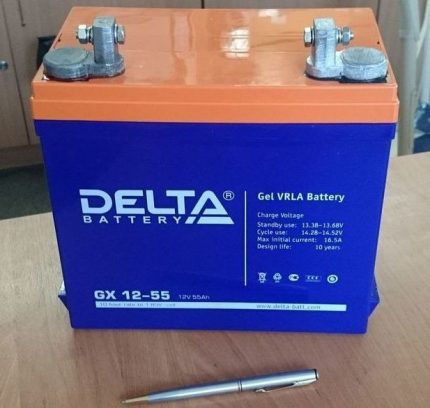
Consider how the battery connects to the controller and inverter.
The next step is to connect the controller to the solar panels, and the battery pack to the inverter.
Stage # 2: connecting to the controller
Consider the option that owners of country houses often use in practice. They order inexpensive equipment manufactured by China on one of the online sites.
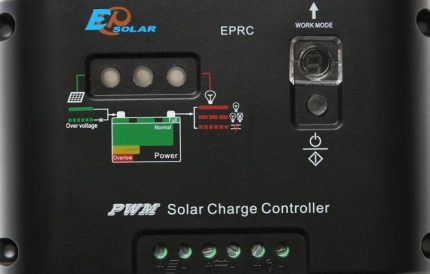
Connection occurs in the following order:
- First, a battery pack is connected to the controller. This is done intentionally to check how the device detects the rated mains voltage (standard values are 12 V, 24 V). When connecting to the battery, the first pair of terminals is used.
- Then directly connect the solar panelsusing the wires that came with them, and the controller has a second pair of terminals.
- Last but not least, night lighting equipment is installedI - for this purpose the third pair of terminals is intended. In addition to low-voltage lighting, which operates exclusively after dark and powered by a battery, other equipment cannot be used.
With any type of connection, it is necessary to monitor the polarity.
Non-observance of polarity leads to an instant breakdown of the controller, as well as the failure of parts of solar panels.
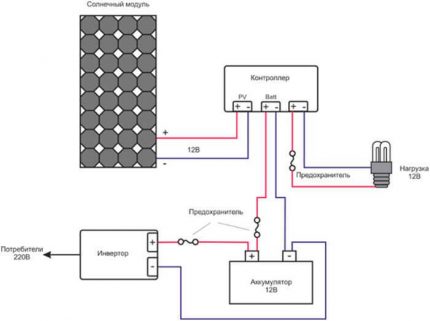
The controller and the battery are constantly interacting. For example, during peak loads, the battery is a buffer that protects the controller from failure.
These two devices, like the other elements of the system, cannot be considered separately. When assembling a solar power plant, each device should be kept in mind, even if the particular connection does not concern it.
Step-by-step instructions for connecting solar panels to the controller
After connecting the controller to the battery and panels, we connect the inverter and, if necessary, low-voltage lighting devices.
Stage # 3: connecting to the inverter
The inverter must be included in the system if the devices in the house operate from 220 V. But there are exceptions when solar panels are installed for the 12 V system, in this case the inverter is not needed.
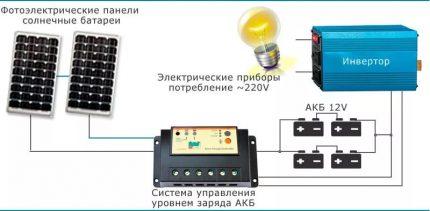
The device is purchased in the same way as the other parts of the solar system: as part of an SES kit or separately.
Procedure for connecting the inverter to the battery:
If you have not previously been involved in the installation of solar power plants, we recommend that you purchase not individual devices, but the complete system.
The advantage of a ready-to-install system is in accordance with the equipment parameters (correctly selected batteries in terms of power, the required number of solar panels, a set of wires for quick connection).
It is logical that devices compatible in capacity, voltage and power will be much more efficient in converting solar energy and providing the house with electricity.In fact, free “green energy” can be used with heating systemspower supply of household appliances.
Conclusions and useful video on the topic
Owners of suburban housing have long appreciated the merits of alternative energy and are actively using SES as a permanent or backup source. Useful recommendations from users of solar power plants will help you with the installation of your own system.
Video # 1. Step-by-step instruction on assembly and connection:
Video # 2. Analysis of common errors when choosing and installing equipment:
Video # 3. An overview of one of the options for home installation:
The use of alternative energy for the needs of mankind is a really big technological leap. Today, every homeowner can independently assemble and connect a solar power station that supplies electricity to the house. Given the payback and environmental friendliness, this is a practical and effective solution.
Want to talk about how to assemble a small solar power plant with your own hands? There are interesting facts and useful information on the topic of the article? Please write comments in the block below, share your impressions, opinions and thematic photos.

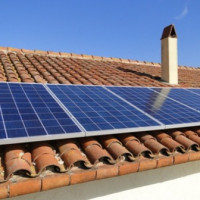 Schemes and methods of connecting solar panels: how to properly install the solar panel
Schemes and methods of connecting solar panels: how to properly install the solar panel 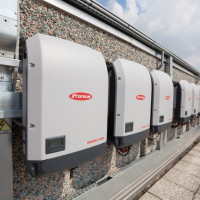 Inverter for solar panels: types of devices, model overview, connection features
Inverter for solar panels: types of devices, model overview, connection features 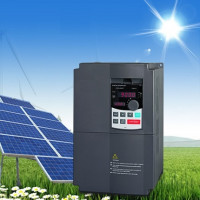 Hybrid inverter for solar panels: types, overview of the best models + connection features
Hybrid inverter for solar panels: types, overview of the best models + connection features 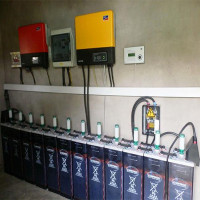 Solar batteries: an overview of the types of suitable batteries and their features
Solar batteries: an overview of the types of suitable batteries and their features 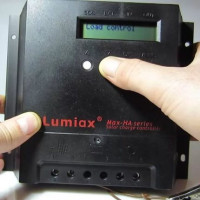 Solar charge controller: circuit, principle of operation, connection methods
Solar charge controller: circuit, principle of operation, connection methods 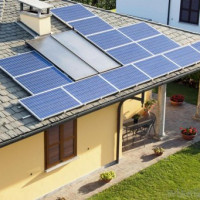 Types of solar panels: a comparative overview of designs and tips for choosing panels
Types of solar panels: a comparative overview of designs and tips for choosing panels  How much does it cost to connect gas to a private house: the price of organizing gas supply
How much does it cost to connect gas to a private house: the price of organizing gas supply  The best washing machines with dryer: model rating and customer tips
The best washing machines with dryer: model rating and customer tips  What is the color temperature of light and the nuances of choosing the temperature of the lamps to suit your needs
What is the color temperature of light and the nuances of choosing the temperature of the lamps to suit your needs  Replacement of a geyser in an apartment: replacement paperwork + basic norms and requirements
Replacement of a geyser in an apartment: replacement paperwork + basic norms and requirements
If we connect several batteries, then the output we get is not 12 volts. The author, in my opinion, is stupid or not in the subject ...
If in series then this is one, if in parallel then a multi-amp power bank.
Sergey, you’re just being stupid. Ever heard of a parallel connection of electrical appliances? If not in the subject, then do not disgrace.
Hello! Please tell me how the voltage is cut off from the common power line? That is, an existing power line (power line), when repairing power lines, or power failure on a common network? Will voltage get to the common line from solar panels? Thank.
Hello. I will try to answer your questions as detailed and simple as possible. I understand that you are interested in the issue of working both from the central power grid and from solar panels at the same time. How the system will behave when the power supply is cut off in the general network and when the performance of solar panels decreases. Regarding the transmission of electricity to the general system, it will be necessary to install a special grid system to give the surplus to the central power grid. For clarity, I will attach the circuit.
Now for other points: you can not worry about failures, if the power of the solar panels subsides, the system will switch to the supply from the central power grid and vice versa. Explain and paint for a long time, everything is controlled by automation, I also attach a visual diagram.
Please tell me, I need the following scheme. There is a 0.4 kV network, there are panels, there is a desire to minimize consumption from the network. It is not possible to compensate completely with panels due to the small installation area, but there is no plan to return the network. How to assemble the circuit?